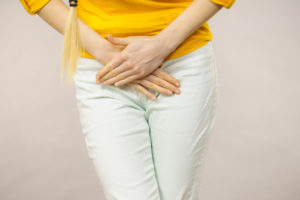Urge incontinence
Urge incontinence is characterized by a sudden and uncontrollable urge to urinate. With urge incontinence, the bladder contracts and squeezes out urine involuntarily. It’s that “gotta go, gotta go” feeling that can be triggered by the sound of running water, being in a car without access to a restroom, or during sexual intercourse. However, it can also be caused by an underlying physical condition.
Leakage with urgency is associated with overactive bladder, frequency, and nocturia (making several trips to the bathroom at night). Urine loss is unpredictable, usually in large amounts, and requires the increased use and number of pads to protect clothing and sitting areas.
Urge incontinence risk factors
There are several conditions that can contribute to urge incontinence. Underlying physical conditions could include:
- Irritation of the bladder.
- Neurological conditions.
- Damage to the spinal cord.
- Infection of the bladder.
- An enlarged prostate (in men).
- Bladder or kidney stones.
- A bladder outlet (sphincter) that doesn’t open properly during urination.
- Cancer.
How does a urologist diagnose urge incontinence?
When diagnosing incontinence, a urologist will start with reviewing the patients personal and family history. They will also review the patient’s symptoms, and order a urinalysis. There are several other tools that will assist in finalizing the diagnosis:
- Voiding or bladder diary.
- Urine analysis – Looking for blood, stone crystals, bacteria.
- Urine culture – Screening for an infection.
- Urine cytology – To determine if cancer cells are present in the urine.
- IVP – This x-ray images the kidneys, ureters, and bladder.
- Kidney ultrasound.
- Bladder ultrasound.
- Cystoscopy – A small scope passed through the urethra to look inside the urethra and the bladder.
- Urodynamics – A test in which small tubes are placed in the rectum and bladder to measure how well the bladder is filling and emptying.
Treatment options for urge incontinence
The treatment for urge incontinence will vary based on the cause. Options may include:
- Medications to make the bladder less irritable.
- Exercises of the pelvic floor muscles.
- Biofeedback and electrical stimulation.
- Bladder training with timed voiding.
- Sacral nerve stimulation- The surgical implantation of a device that interacts with the nerves going into and out of the bladder making the bladder less irritable. Interstim® therapy for urinary control is a reversible treatment for people with urge incontinence caused by overactive bladder.
If you are experiencing any type of urinary leakage, contact Urology Austin to schedule an appointment with one of our providers.

